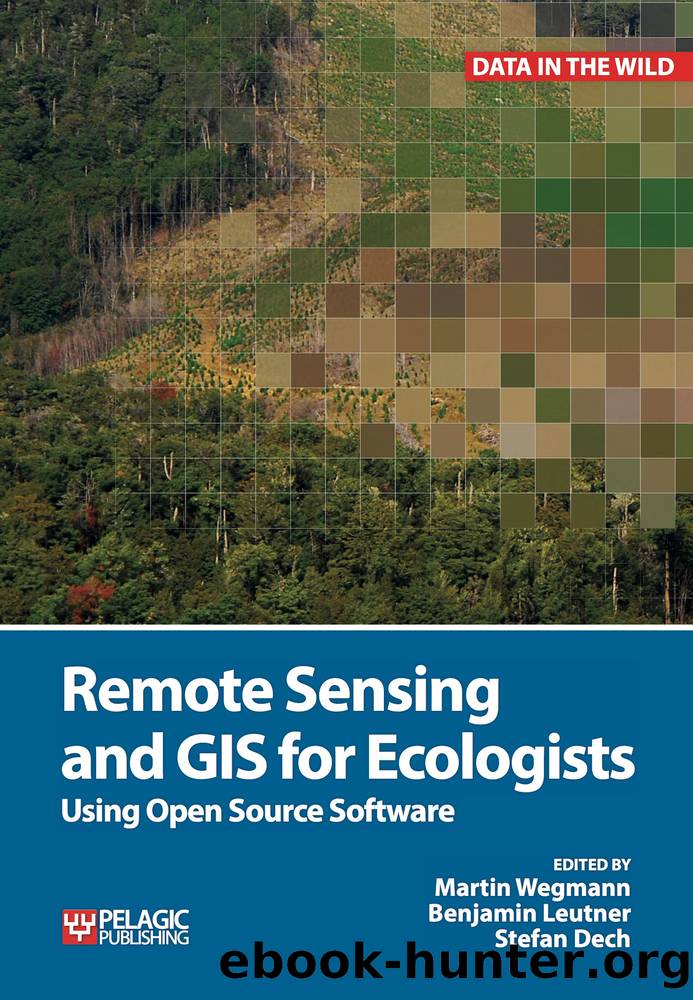Remote Sensing and GIS for Ecologists by Martin Wegmann

Author:Martin Wegmann
Language: eng
Format: epub
Publisher: DATA IN THE WILD
Published: 2015-07-14T16:00:00+00:00
8 Land Cover or Image Classification Approaches
Ned Horning, Benjamin Leutner and Martin Wegmann
A land cover classification is in fact just a conversion of multiple input layers to groups of pixels with similar characteristics (Figure 8.1) and in our case spatially explicit (Figure 8.2). The resulting pixel values are used to identify different land cover classes that are either defined a priori (supervised classification) or with a clustering algorithm (unsupervised classification).
8.1 Conducting Image Classification Scenarios
The partitioning of a landscape into different classes is one of the most established approaches in remote sensing to represent an area as an easy-to-understand map (Figure 8.3). A classification is useful to quantify landscape features for modelling or other types of analysis. For example, you can use a classified map to retrieve area estimates of forest cover or you can compare it to another time period to report forest cover loss (see Chapter 9). You can also build on it to derive landscape metrics, such as forest patch size or degree of fragmentation. Land cover maps are helpful as visual tools for decision-makers or the general public since they present a simplified version of the landscape, making it easier to understand the size, shape and location of a few land cover types instead of the sometimes complex rendering of the landscape in a satellite image or aerial photograph.
Download
This site does not store any files on its server. We only index and link to content provided by other sites. Please contact the content providers to delete copyright contents if any and email us, we'll remove relevant links or contents immediately.
| Anatomy | Animals |
| Bacteriology | Biochemistry |
| Bioelectricity | Bioinformatics |
| Biology | Biophysics |
| Biotechnology | Botany |
| Ecology | Genetics |
| Paleontology | Plants |
| Taxonomic Classification | Zoology |
Sapiens: A Brief History of Humankind by Yuval Noah Harari(13054)
The Tidewater Tales by John Barth(12030)
Do No Harm Stories of Life, Death and Brain Surgery by Henry Marsh(6337)
Mastermind: How to Think Like Sherlock Holmes by Maria Konnikova(6236)
The Thirst by Nesbo Jo(5786)
Why We Sleep: Unlocking the Power of Sleep and Dreams by Matthew Walker(5644)
Sapiens by Yuval Noah Harari(4537)
Life 3.0: Being Human in the Age of Artificial Intelligence by Tegmark Max(4509)
The Longevity Diet by Valter Longo(4446)
The Rules Do Not Apply by Ariel Levy(3906)
The Immortal Life of Henrietta Lacks by Rebecca Skloot(3826)
The Body: A Guide for Occupants by Bill Bryson(3802)
Why We Sleep by Matthew Walker(3773)
Animal Frequency by Melissa Alvarez(3755)
Yoga Anatomy by Kaminoff Leslie(3702)
Barron's AP Biology by Goldberg M.S. Deborah T(3632)
The Hacking of the American Mind by Robert H. Lustig(3580)
All Creatures Great and Small by James Herriot(3517)
Yoga Anatomy by Leslie Kaminoff & Amy Matthews(3396)
